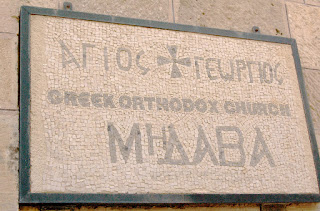Today, Medebah is known for an enormous mosaic map of the Holy Lands. This map was uncovered in the 19th century as they built St. George's Greek Orthodox church on top of where a Byzantine church once was. This mosaic they uncovered was the original church's floor. It is the oldest known map of the Holy Lands and includes Egypt and the Nile as well as Jerusalem surrounded by a large wall. The details are astounding and the map is beautiful. In fact, this map is so accurate that archaeologists have used it to help them uncover Biblical sites that they were unsure of their whereabouts. Isn't that cool?
We had to wait outside of St. George's church as it was a Sunday morning and they were just finishing their mass. As we waited outside, our guide, Fadi, explained what we would be seeing and told us what to look for once inside the church. I was standing (trying to be in the shade) right under an olive tree. I have never been so close to an olive branch before!
I had always been under the impression that a mosaic was made of tiles - well, these mosaics are made from tiny pieces of colorful stones! Very lovely! Notice the intricate details and apparently the scale of the map is remarkable as well!
Map showing the wall around Jerusalem, complete with the Cardo on which we walked!

Map depicting Jordan River (complete with fish swimming) flowing into Dead Sea.
Other scenes from inside St. George's Church
Prayer Candles from the Service
While as a reformed Christian, I am not too fond of icons - it is good for me to remember that these icons were originally "object" lessons for leaders of the church to use to teach about the truths of Scripture. During those days, so few people could read a Bible - or even had access to one. Icons were used to tell stories from Scripture, to help the common people learn more about the Bible. At some point, unfortunately, these icons ceased to be objects of information and instead became objects of worship. With my catholic background, some of these orthodox and catholic churches were difficult for me to visit. It just made me really sad and empty feeling. I just don't want to be reminded of from whence I've come.







No comments:
Post a Comment